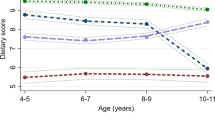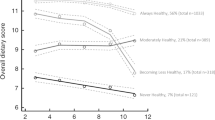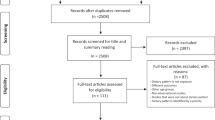Abstract
We investigated the cross-sectional association between parental history of hypertension and dietary intakes among early adolescent schoolchildren. A total of 1845 participants aged 12 years had complete data on diet and parental medical history, and thus they were included in the final analyses. Dietary data were assessed from validated semi-quantitative food-frequency questionnaires. Parents completed questionnaires about their medical conditions. Cases where the biological mother and/or father had hypertension were classified as positive parental history of hypertension. After multivariable adjustment, participants with positive versus negative parental history of hypertension had 33% greater likelihood of consuming soft drinks ⩾1 per week. Boys with a parental history versus boys without a parental history of hypertension consumed more energy-dense, nutrient-poor foods: 379.4 g per day and 318.0 g per day, respectively, P=0.02. Girls with a positive versus a negative parental history consumed more vegetables: 164.1 versus 142.6 g per day, P=0.01. Significant associations were not observed between those with and those without a positive parental history in mean dietary intakes of carbohydrates, fats, sugars and sodium. Children with a positive parental history of hypertension were 67% more likely to simultaneously engage in three unhealthy lifestyle behaviors (excessive recreational screen viewing, high consumption of snacks and and high consumption of soft drinks). Parental hypertension was associated with unhealthy dietary behaviors among offspring, including higher consumption of soft drinks and energy-dense, nutrient-poor foods.
This is a preview of subscription content, access via your institution
Access options
Subscribe to this journal
Receive 12 digital issues and online access to articles
$119.00 per year
only $9.92 per issue
Buy this article
- Purchase on Springer Link
- Instant access to full article PDF
Prices may be subject to local taxes which are calculated during checkout
Similar content being viewed by others
References
Bao W, Srinivasan SR, Valdez R, Greenlund KJ, Wattigney WA, Berenson GS . Longitudinal changes in cardiovascular risk from childhood to young adulthood in offspring of parents with coronary artery disease: the Bogalusa Heart Study. JAMA 1997; 278: 1749–1754.
Solini A, Santini E, Passaro A, Madec S, Ferrannini E . Family history of hypertension, anthropometric parameters and markers of early atherosclerosis in young healthy individuals. J Hum Hypertens 2009; 23: 801–807.
Neutel JM . Why lowering blood pressure is not enough: the hypertension syndrome and the clinical context of cardiovascular risk reduction. Heart Dis 2000; 2: 370–374.
Gopinath B, Baur LA, Hardy LL, Wang JJ, Teber E, Wong TY et al. Parental history of hypertension is associated with narrower retinal arteriolar caliber in young girls. Hypertension 2011; 58: 425–430.
Gopinath B, Hardy LL, Baur LA, Teber E, Mitchell P . Influence of parental history of hypertension on screen time and physical activity in young offspring. J Hypertens 2012; 30: 336–341.
Claassen L, Henneman L, van der WT, Marteau TM, Timmermans DR . Being at risk for cardiovascular disease: perceptions and preventive behavior in people with and without a known genetic predisposition. Psychol Health Med 2012; 17: 511–521.
Ojaimi E, Rose KA, Smith W, Morgan IG, Martin FJ, Mitchell P . Methods for a population-based study of myopia and other eye conditions in school children: the Sydney Myopia Study. Ophthalmic Epidemiol 2005; 12: 59–69.
Watson JF, Collins CE, Sibbritt DW, Dibley MJ, Garg ML . Reproducibility and comparative validity of a food frequency questionnaire for Australian children and adolescents. Int J Behav Nutr Phys Act 2009; 6: 62.
Food Standards Australia New Zealand. NUTTAB 2006. FSANZ: Canberra, Australia, 2007.
Food Standards Australia New Zealand. NUTTAB 2010. FSANZ: Canberra, Australia, 2010.
Food Standards Australia New Zealand. AUSNUT 2007. FSANZ: Canberra, Australia, 2007.
Louie JC, Flood V, Turner N, Everingham C, Gwynn J . Methodology for adding glycemic index values to 24-hour recalls. Nutrition 2011; 27: 59–64.
Flood A, Subar AF, Hull SG, Zimmerman TP, Jenkins DJ, Schatzkin A . Methodology for adding glycemic load values to the National Cancer Institute Diet History Questionnaire database. J Am Diet Assoc 2006; 106: 393–402.
Hardy LL, Grunseit A, Khambalia A, Bell C, Wolfenden L, Milat AJ . Co-occurrence of obesogenic risk factors among adolescents. J Adolesc Health 2012; 51: 265–271.
Strong WB, Malina RM, Blimkie CJ, Daniels SR, Dishman RK, Gutin B et al. Evidence based physical activity for school-age youth. J Pediatr 2005; 146: 732–737.
Rossow I, Rise J . Concordance of parental and adolescent health behaviors. Soc Sci Med 1994; 38: 1299–1305.
Scaglioni S, Salvioni M, Galimberti C . Influence of parental attitudes in the development of children eating behaviour. Br J Nutr 2008; 99 (Suppl 1): S22–S25.
Brug J, van Stralen MM, te Velde SJ, Chinapaw MJ, De BI, Lien N et al. Differences in weight status and energy-balance related behaviors among schoolchildren across Europe: the ENERGY-project. PLoS One 2012; 7: e34742.
Shomaker LB, Tanofsky-Kraff M, Savastano DM, Kozlosky M, Columbo KM, Wolkoff LE et al. Puberty and observed energy intake: boy, can they eat!. Am J Clin Nutr 2010; 92: 123–129.
Knutsen SF, Knutsen R . The Tromso Survey: the family intervention study—the effect of intervention on some coronary risk factors and dietary habits, a 6-year follow-up. Prev Med 1991; 20: 197–212.
Sivapalaratnam S, Boekholdt SM, Trip MD, Sandhu MS, Luben R, Kastelein JJ et al. Family history of premature coronary heart disease and risk prediction in the EPIC-Norfolk prospective population study. Heart 2010; 96: 1985–1989.
Kardia SL, Modell SM, Peyser PA . Family-centered approaches to understanding and preventing coronary heart disease. Am J Prev Med 2003; 24: 143–151.
Acknowledgements
The Sydney Myopia Study (Sydney Childhood Eye Study) was supported by the Australian National Health & Medical Research Council (Grant No. 253732); the Westmead Millennium Institute, University of Sydney; the Vision Cooperative Research Centre, University of New South Wales, Sydney; and the National Heart Foundation of Australia (Grant No. G11S 6106), Melbourne, Australia.
Author information
Authors and Affiliations
Corresponding author
Ethics declarations
Competing interests
The authors declare no conflict of interest.
Additional information
Author contributions
Study concept and design: BG; acquisition of data: PM; analysis and interpretation of data: BG, JCYL, VMF, ER, LAB and PM; drafting of the manuscript: BG; critical revision of the manuscript: BG, JCYL, VMF, ER, LAB and PM.
Rights and permissions
About this article
Cite this article
Gopinath, B., Louie, J., Flood, V. et al. Parental history of hypertension and dietary intakes in early adolescent offspring: a population-based study. J Hum Hypertens 28, 721–725 (2014). https://doi.org/10.1038/jhh.2014.12
Received:
Revised:
Accepted:
Published:
Issue Date:
DOI: https://doi.org/10.1038/jhh.2014.12



